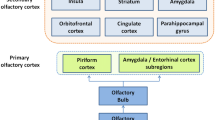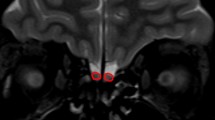Abstract
This study was conducted to determine the temporal pattern of lateralized congestion of the nasal mucosa. Thirteen female and 15 male healthy subjects (median age, 27 years) were examined using magnetic resonance imaging (MRI) at a 0.2-T system every 30 min. Contiguous coronal T1-weighted imaging was performed covering the entire nasal cavity. Subjects were investigated over periods of up to 4 h (n = 28) or up to 14 h (n = 6), respectively. Nasal cavity volumes were measured by manual segmentation of the acquired images and summation of areas. Additionally, olfactory testing was performed. All subjects exhibited normal olfactory function. The minimum unilateral volume of the nasal cavity during congestion was 2.2 cm3, and maximum volume during decongestion was 17.0 cm3 (mean, 7.7 cm3). Seven subjects exhibited minor fluctuation of their nasal volumes. In contrast, 21 subjects showed nasal cyclicity. Maximum fluctuation of the volume of the nasal cavity was found in the vicinity of the turbinates in the central and posterior nasal cavity. The length of the nasal cycle showed high variability and was in the range of 180 to 280 min. No correlation was found between nasal volumes and olfactory scores. Using MRI, the present study is the first to report differences with regard to both the presence of a nasal cycle in an individual subject and the length of the nasal cycle. Considering that nasal congestion is of significance to human well-being, the present observations may influence clinical decisions.




Similar content being viewed by others
References
Brooks CD, Karl KJ, Francom SF (1991) Unilaterality of obstruction after acute nasal allergen provocation. Relation of allergen dose, nasal reactivity and the nasal cycle. Clin Exp Allergy 21(5):583–587
Corey JP, Gungor A, Nelson R, Fredberg J, Lai V (1997) A comparison of the nasal cross-sectional areas and volumes obtained with acoustic rhinometry and magnetic resonance imaging. Otolaryngol Head Neck Surg 117(4):349–354
Croce C, Fodil R, Durand M, Sbirlea-Apiou G, Caillibotte G, Papon JF et al (2006) In vitro experiments and numerical simulations of airflow in realistic nasal airway geometry. Ann Biomed Eng 34(6):997–1007
Damm M, Vent J, Schmidt M, Theissen P, Eckel HE, Lotsch J et al (2002) Intranasal volume and olfactory function. Chem Senses 27(9):831–839
Eccles R, Jawad MS, Morris S (1989) Olfactory and trigeminal thresholds and nasal resistance to airflow. Acta Otolaryngol 108(3–4):268–273
Ehrenstein WH, Ehrenstein A (1999) Psychophysical methods. In: Windhorst U, Johansson H (eds) Modern techniques in neuroscience research. Springer, Berlin, pp 1211–1241
Fisher EW, Scadding GK, Lund VJ (1993) The role of acoustic rhinometry in studying the nasal cycle. Rhinology 31(2):57–61
Flanagan P, Eccles R (1997) Spontaneous changes of unilateral nasal airflow in man. A re-examination of the ‘nasal cycle’. Acta Otolaryngol 117(4):590–595
Fonseca MT, Voegels RL, Pinto KM (2006) Evaluation of nasal volume by acoustic rhinometry before and after physical exercise. Am J Rhinol 20(3):269–273
Grutzenmacher S, Lang C, Mlynski R, Mlynski B, Mlynski G (2005) Long-term rhinoflowmetry: a new method for functional rhinologic diagnostics. Am J Rhinol 19(1):53–57
Gungor A, Moinuddin R, Nelson RH, Corey JP (1999) Detection of the nasal cycle with acoustic rhinometry: techniques and applications. Otolaryngol Head Neck Surg 120(2):238–247
Huang ZL, Ong KL, Goh SY, Liew HL, Yeoh KH, de Wang Y (2003) Assessment of nasal cycle by acoustic rhinometry and rhinomanometry. Otolaryngol Head Neck Surg 128(4):510–516
Hummel T, Sekinger B, Wolf SR, Pauli E, Kobal G (1997) “Sniffin' sticks”: olfactory performance assessed by the combined testing of odor identification, odor discrimination and olfactory threshold. Chem Senses 22:39–52
Kayser R (1895) Die exacte Messung der Luftdurchgängigkeit der Nase. Arch Laryngol Rhinol 3:110–115
Kennedy DW, Zinreich SJ, Kumar AJ, Rosenbaum AE, Johns ME (1988) Physiologic mucosal changes within the nose and ethmoid sinus: imaging of the nasal cycle by MRI. Laryngoscope 98(9):928–933
Kobal G, Klimek L, Wolfensberger M, Gudziol H, Temmel A, Owen CM et al (2000) Multicenter investigation of 1,036 subjects using a standardized method for the assessment of olfactory function combining tests of odor identification, odor discrimination, and olfactory thresholds. Eur Arch Otorhinolaryngol 257:205–211
Mirza N, Kroger H, Doty RL (1997) Influence of age on the ‘nasal cycle’. Laryngoscope 107(1):62–66
Ohki M, Ogoshi T, Yuasa T, Kawano K, Kawano M (2005) Extended observation of the nasal cycle using a portable rhinoflowmeter. J Otolaryngol 34(5):346–349
Stoksted P (1953) Rhinometric measurements for determination of the nasal cycle. Acta Otolaryngol Suppl 109:159–175
Tausche E, Deeb W, Hansen L, Hietschold V, Harzer W, Schneider M (2009) CT analysis of nasal volume changes after surgically-assisted rapid maxillary expansion. J Orofac Orthop 70(4):306–317
Wang K, Denney TS Jr, Morrison EE, Vodyanoy VJ (2005) Numerical simulation of air flow in the human nasal cavity. Conf Proc IEEE Eng Med Biol Soc 6:5607–5610
Zinreich SJ, Kennedy DW, Kumar AJ, Rosenbaum AE, Arrington JA, Johns ME (1988) MR imaging of normal nasal cycle: comparison with sinus pathology. J Comput Assist Tomogr 12(6):1014–1019
Acknowledgments
The authors thank Thomas J. Vogl, chairman of the Institute for Diagnostic and Interventional Radiology at the Johann Wolfgang Goethe University in Frankfurt, Germany, for kindly providing acquisition time at the MR scanner. Additionally, the authors thank technicians Julia Balzer and Lars Baier for their assistance during the MRI data acquisition.
Compliance with Ethics Requirements
ᅟ
Conflict of Interest
Nasreddin Abolmaali declares that he has no conflict of interest.
Antonio Kantchew declares that he has no conflict of interest.
Thomas Hummel declares that he has no conflict of interest.
All procedures followed were in accordance with the ethical standards of the responsible committee on human experimentation (institutional and national) and with the Helsinki Declaration of 1975, as revised in 2008. Informed consent was obtained from all patients for being included in the study.
Author information
Authors and Affiliations
Corresponding author
Rights and permissions
About this article
Cite this article
Abolmaali, N., Kantchew, A. & Hummel, T. The Nasal Cycle: Assessment Using MR Imaging. Chem. Percept. 6, 148–153 (2013). https://doi.org/10.1007/s12078-013-9150-3
Received:
Accepted:
Published:
Issue Date:
DOI: https://doi.org/10.1007/s12078-013-9150-3




